the orange show center for visionary art's
eyeopener tours:
Pittsburgh to Cincinnati, 2005


"Da Burgh, The Nati, Two Saints, Two Franks, a Temple, a Castle and a Very Big Basket"
tour report by Marks Hinton
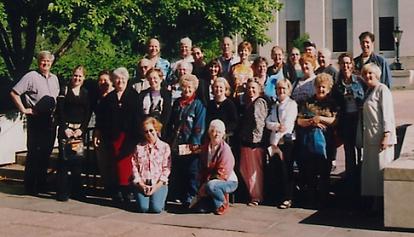
It is with a heavy heart that I begin this chronicle of the Eyeopener Tour of the Ohio River
Valley 2005 because, dear reader, I have good news and bad news. In case of the former it was
once again a mind boggling adventure as each have been over the past few years. The bad news
is that our visionary leader, Larry Harris, the Archbishop of Architecture, the Fomalhaut of
Folk Art, the Caravaggio of Churches, the Einstein of Environments, the Marciano of Museums
and the Bach of Burial Grounds, is taking a sabbatical in 2006. Picture the Bulls without
Jordan, the 49ers sans Montana or the Yankees missing Ruth. It places a heavy burden next
year on the rest of the Committee to step up and play our best game without our best player.
But now let us proceed with the matter at hand. Much to our surprise Larry did not arrange
the departure wake up call at 4 AM as has been the case in recent years. Instead we were
scheduled to leave Houston at the very civilized hour of 6:45 PM on Wednesday, May 25.
However, the powers that be who operate the airport decided to only open one runway (well it
was Memorial Day weekend and maybe they were on vacation). As a result we had 28 other
aircraft ahead of us in the take off queue. After almost a two hour wait (incoming aircraft
also shared the same runway) we departed for Pittsburgh, our first destination. On arrival we
immediately got to know our travel companions well as the Holiday Inn sent just one van to
take all 28 of us to the motel. We christened it the Sardine Shuttle. We also encountered our
first driver who seemed to get sadistic pleasure from slamming on the breaks, sending
participants and gear lurching hither and yon. It was a foretaste of our meeting with "Braking"
Bob, our Kamikaze coach driver.
The rosy fingers of dawn on Thursday indicated we were to be treated to a marvelous day both
weather-wise and more importantly for the cornucopia of delights that out tour leader had
selected for our viewing pleasure. Leaving Pittsburg in our exhaust, our merry little band
headed toward western Pennsylvania, stopping along the way at the historic, 98 year-old Summit
Inn in Farmington for a wonderful lunch. We discovered earlier guests here included Thomas
Edison, Henry Ford, Franklin Roosevelt and Harry Truman.
Following a 30-minute drive through verdant hills we arrived at Kentuck Knob, an upscale
Usonian Frank Lloyd Wright house built in 1954 in the Laurel Highlands for the I. N. Hagan
family. When constructed, there were no trees on this outcropping. However, the Hagans
planted 50,000 saplings and now this gem is surrounded by acres of green. Today the home is
owned by an Englishman, Lord Peter Palumbo, who collects architecture (Sir Pete must have some
serious dinero) and large contemporary sculptures. The woodland trails and meadows surrounding
the house are filled with monumental works by Claes Oldenburg, Ray Smith and Andy Goldsworthy
to mention a few.

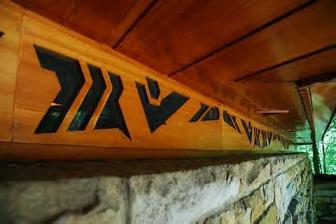
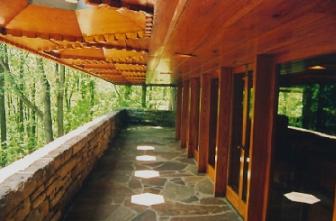
 photos by Tom LaFaver
photos by Tom LaFaver
Kentuck Knob, Chalk Hill, PA
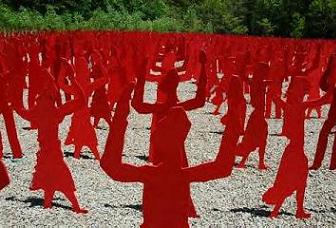
 photo by Tom LaFaver
photo by Tom LaFaver
Ray Smith's "Red Army" at the
Kentuck Knob sculpture garden
A short drive from Kentuck Knob brought us to what the American Institute of Architects called
"the best all-time work of American architecture," Frank Lloyd Wright's masterpiece,
Fallingwater. No photograph can do justice to this magnificent structure and its idyllic
location. It exceeds all expectations no matter how elevated they may be. We took
the two-hour premium tour which took us to every nook and cranny. It was two hours of mind
boggling experiences. What makes Fallingwater even more phenomenal is that Wright, after
procrastinating for months, designed this country retreat in less than four hours as the
client, Edgar J. Kaufmann was in route to Taliesin, the architect's headquarters in Spring
Green, Wisconsin, from a business meeting in Chicago. Wright once said "I can just shake the
sleeve of my coat and plans fall out." Maybe he was not exaggerating. If anyone ever doubted
his genius the story of Fallingwater will erase any skepticism.

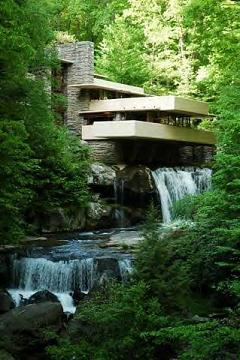
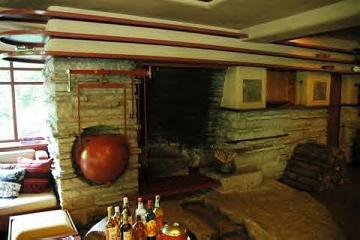
 photos by Tom LaFaver
photos by Tom LaFaver
Fallingwater, Mill Run, PA
Our next stop was at the home of Rob and Ada Brandegee for a viewing of their eclectic art
collection. Situated on the top floor of a warehouse loft overlooking the Monongahela River
these two collectors have amassed a world class folk art collection. Our gracious hosts
served the group an excellent zinfandel and chardonnay (thank goodness they followed the
Sideways rule: no merlot) along with a selection of fine cheeses. It is these visits to
private homes that add a truly special element to our Eyeopener Tours.
How our silver-tongued tour leader convinces these wonderful folks to allow 28 strangers to descend on their private space is a mystery to me.
We wrapped up day two with a fine meal at the Grand Concourse, a restaurant in
one of Pittsburgh's former railroad stations, a historic structure that has been lovingly preserved and restored.
We overnighted at the renovated William Penn Hotel although none of us met its famous ghost during our stay.
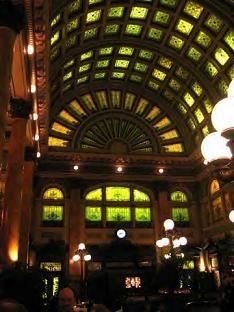
 photo by Tom LaFaver
photo by Tom LaFaver
The Grand Concourse Restaurant, Pittsburgh, PA
Day three kicked off with a visit to St. Anthony's Chapel in the Troy Hill section
of Pittsburgh, not far from the birthplace of pop artist Andy Warhol. Few clues from the
exterior of this brick church indicate the treasures contained within. Our docent, a
pixie-like Irish nun named Sister Margaret, explained how Father Suitbert Mollinger amassed
the world's second largest collection, after the Vatican, of sacred relics. Sister Margaret
personally cataloged the collection over a three year period. Among these holy objects are
pieces of the True Cross as well as objects belonging to St. John the Baptist, Saints
Catherine, Barbara and Sebastian and Mary Magdalene (any Di Vinci Code believers?) among
others.

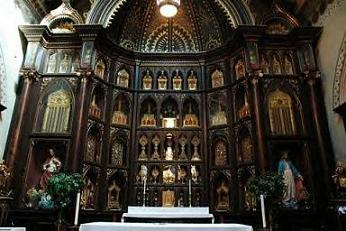
 photo by Tom LaFaver
photo by Tom LaFaver
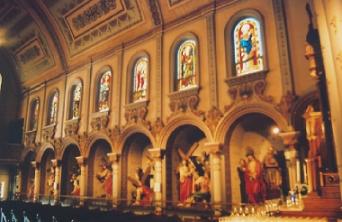
 photo by Larry Harris
photo by Larry Harris
St. Anthony's Chapel, Pittsburgh, PA
We continued on this religious pilgrimage with our next visit, St. Nicholas Croatian
Catholic Church in the city's Millvale suburb. This unpretentious house of worship may
have been the sleeper of the entire tour. In the late 1800s thousands of Croatians immigrated
to Pittsburgh to seek employment in the steel mills (the high tech companies of that time).
Father Albert Zagar, the church pastor, commissioned a well-known European artist who had also
moved to the Steel City to paint murals telling of the homeland, the Croats, traditional
religious themes and social issues of the day. Between 1937 and 1941 Maxo Vanka covered the
entire nave of this church with 22 incredible WPA style murals. Religious subjects include
Mary, Queen of Croatians, the Crucifixion, Pieta and Evangelists. Social murals focus on
subjects like war, poverty, injustice and abuses of the capitalist system. He also painted
pastoral scenes from Croatia and women in traditional dress comforting a mother whose son had
been killed in battle. These remarkable murals are a must see for anyone visiting Pittsburgh.

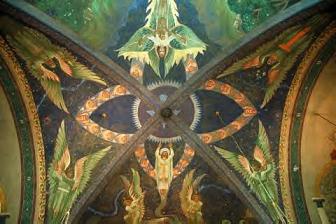
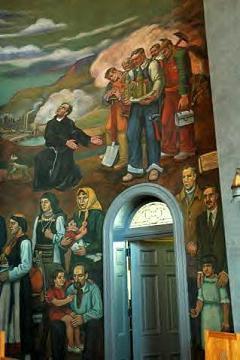
 photos by Tom LaFaver
photos by Tom LaFaver
St. Nicholas Croatian Catholic Church, Pittsburgh, PA
Then it was time to bid Pennsylvania adieu, cross West Virginia in seven minutes (actually it
was only a five mile wide strip of the state) and pay a visit to the Buckeye State, Ohio.
Many of us were curious as to exactly what a buckeye is. So we began asking Ohioans to
explain this to us. This effort greatly resembled Jay Leno doing his "Jaywalking" on the
Tonight Show. Some of the answers were rather humorous. However, we finally determined it is a
spiny, highly poisonous nut produced by the buckeye tree.
A sumptuous lunch was served at the Pro's Table in New Philadelphia
(so named because its founder, John Kinsley, had the city laid out in a grid pattern similar
to Philadelphia, PA and named many of its streets the same as in that city). Then it was off
to Dover for a visit to the Warther Carvings Museum. In about 1895 young Ernest "Mooney"
Warther found a penknife and began whittling to pass the time while tending a herd of cows.
By 1920 he was a master carver and began his life work producing 55 ebony, ivory and walnut
train carvings. It is impossible to describe the meticulous detail of these railroad trains.
You have to see it to believe this man's obsession with perfection. He is to train carving
what Rembrandt is to oil painting. During the depths of the Great Depression the New York
Central Railroad offered Mooney $50,000 plus $5,000 annually if he would let them keep just
one of the models at Grand Central Terminal in New York City. He turned them down. In addition
to the museum there are eight acres of gardens, a button house and a factory that produces
hand crafted cutlery.

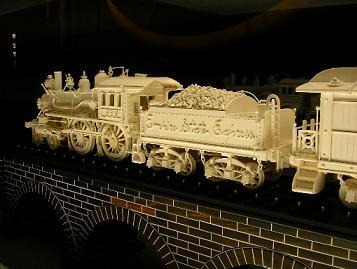
 photo by Barbara Hinton
photo by Barbara Hinton
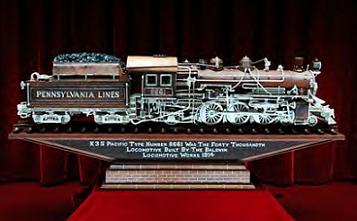
 photo by Tom LaFaver
photo by Tom LaFaver
Warther Carvings Museum, Dover, OH
Over the years we've seen some Big Things on the roadsides, but after you have feasted your eyes on the
Big Basket there is little reason to ask for any more. The Longaberger Company headquarters
is a real Eyeopener. This seven story building is in the shape of a huge woven picnic basket
complete with 70-ton, 331-foot long handles mounted on top. The ants attacking this picnic
would be the size of those in the 1954 sci-fi flick, Them, staring James Whitmore and James
Arness. Then it was off to Columbus for more treats.

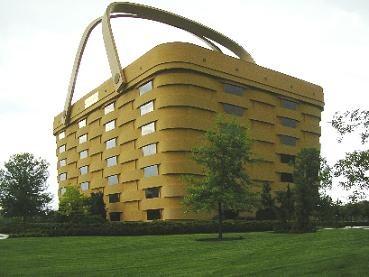
 photo by Barbara Hinton
photo by Barbara Hinton
Longaberger Company Home Office, Newark, OH
Following an excellent dinner of Asian cuisine at Liu Pon Xi restaurant we proceeded to
the Lindsay Gallery. Duff Lindsay, a nationally-known gallery owner and folk art
collector, was kind enough to host an event for tour members featuring carvings, paintings and
sculpture by regional artists who also were in attendance to talk about their work. The Lindsay's "Ohio Folk"
exhibit featured work by Roy Butcher, Stanley Greer, Vivian Pitman, Janis Price, and Chad Sines.
Copious amounts of champagne flowed, music by a local duo wafted through the gallery and many
participants took this opportunity to add pieces to their own collection. On the walk back to
the motel some participants were seen going into the famous White Castle hamburger joint to
indulge their palates with a sack of those tiny delights better know as "belly bombs". Later
the nightcap of choice was Alka-Seltzer.

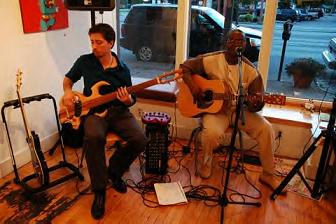

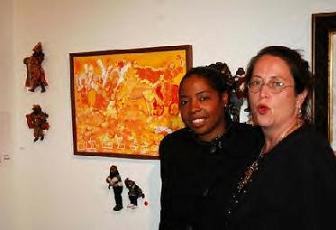
 photos by Tom LaFaver
photos by Tom LaFaver
The Lindsay Gallery, Columbus, OH
Day four was dedicated to wonderful folk art environments and outstanding architecture.
Thanks to CAPA, Columbus largest non-profit arts organization, we were able to visit the Ohio
Theater, a 1928 Beaux Arts and Spanish Baroque motion picture house saved from the
wrecking ball and restored to its former glory. This magnificent structure is architecturally over-the-top with gold
columns, stained glass, chandeliers, furnishings (the Ladies Room had tables for
writing post cards), velvet curtains, classic French oil paintings and sculpted ceilings.

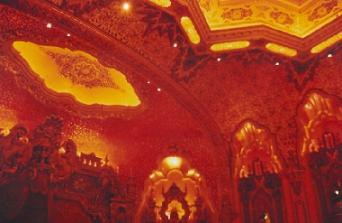
 photo by Larry Harris
photo by Larry Harris
The Ohio Theater, Columbus, OH
Located just across the street from the theater is the Ohio State Capitol, a Greek Revival
masterpiece that was even given a favorable review by Frank Lloyd Wright, who tossed
complements around like they were manhole covers. Highlights here included the almost
Victor Vasarely-like floor pattern below the rotunda drum, a marble sculpture of Ulysses S.
Grant meeting with his generals during the Battle Of Vicksburg, primrose carpet in the House
and Senate chambers and a multi-colored stone map of Ohio in the basement pinpointing every
county. Thanks again to Nancy Recchie and Jeff Darbee for their enlightening tour.

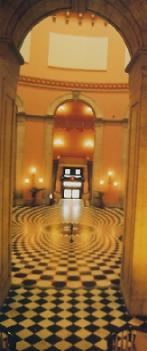
 photo by Larry Harris
photo by Larry Harris
The Ohio Statehouse, Columbus, OH
The Columbus Art Museum owns the Elijah Pierce Folk Art Collection. We were fortunate to have
Nannette Maciejunes, Museum Director, as our guide to describe this huge assemblage of
Pierce's wood carvings. A deeply religious man, he carved many works to show his devotion to
God. In addition he produced numerous animal sculptures and works of a personal nature like
his escaping a lynch mob. Then we took a behind-the-scenes tour of the museums basement to
view other works by Pierce that were not currently on display. If you are a Elijah Pierce fan
a pilgrimage to this museum should be in your plans.

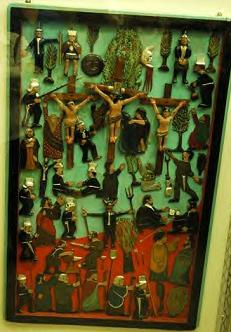
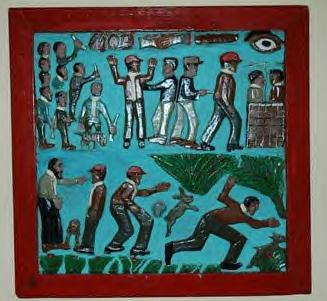
 photo by Tom LaFaver
photo by Tom LaFaver
The art of Elijah Pierce, Columbus Museum of Art, Columbus, OH
"Guten essen", said the zaftig hostess as we entered Schmidt's Restaurant und Sausage Haus.
Little did we know just how guten the essen was going to be. Located in the historic German
Village area, five generations of the Schmidt family has been serving up sausage plates,
schnitzel, sauerbraten, cabbage rolls, spatzel and one pound creampuffs. Andy Schmidt
personally presided over what many of our band considered the best food on a trip filled with
top notch cuisine. We descended on the splendiferous buffet like a horde of locusts hitting
an Iowa corn field. Steaming chaffing dishes piled high with salad fixings and homemade ranch
dressing, spatzel and chicken soup, wursts, German potato salad, sauerkraut, green beans and,
of course, cream puffs. It was a meal for the ages.
A well-constructed folk art environment can stand the test of time even without an annual maintenance budget. Such is the case of the Hartman Rock Garden in Springfield. Like 25% of
Americans Ben Hartman lost his job in 1932 during the Great Depression. Not one to sit by and
idle the time away he began construction of this rock garden in the side yard of his home.
He built a cathedral complete with statues of saints, castle with a moat and drawbridge,
saguaro cactus, Mount Vernon with slave cabins, fish pond and more, then surrounded the whole
shooting match with a concrete picket fence complete with gate that is so realistic without
seeing some rebar where the fence has been damaged you would swear it was wooden.

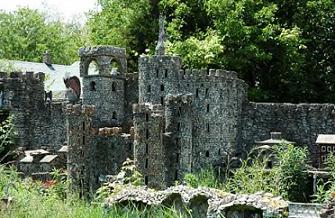
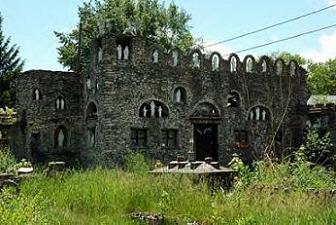
 photos by Tom LaFaver
photos by Tom LaFaver
The Hartman Rock Garden, Springfield, OH
From the rock garden it was on to Sidney to see another of architect Louis Sullivan's Midwest
jewel box banks. We had visited three other Sullivan banks on previous Eyeopener tours and
the Peoples Federal Savings and Loan did not disappoint. The red brick exterior showcases the
blue-green stained glass windows and blue tile archway over the entrance with the word "Thrift"
in silver tiles. The façade contains lions with shields, lion heads, complex geometric
patterns and leafy stone foliage. Look for Sullivan's signature over the main door.

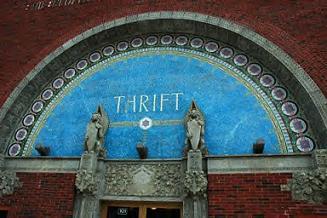
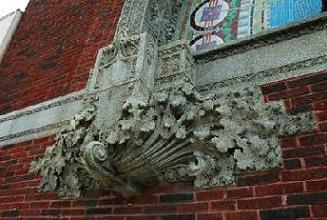
 photos by Tom LaFaver
photos by Tom LaFaver
Peoples Federal Savings and Loan, Sidney, OH
In prehistoric times ancestors of present day Ohioans were known for their mound building.
Little did we know that we were about to meet a man with a passion for erecting similar
structures in the small town of Wapakoneta. The exterior of Jim Bowsher's modest two-story
home on a quiet street carefully masks what lies behind the front door and out into the huge
backyard. This writer, artist, archeologist and lecturer has the enthusiasm of a Tasmanian
devil on amphetamines. He always has "one more story" and it’s usually a good one. Jim's
backyard reminds one of the ancient stone henges scattered throughout the British Isles. And
like those famous sites this place is also a temple, specifically the Temple of Tolerance. The
main temple is a 20-foot high pile of boulders crowned by an alter fronted by ancient Irish
mood dog carvings. It is surrounded by smaller temples, a Viet Nam War memorial, meditation
garden with a bench once slept on by James Dean, a monument to love (in this case erected for
his wife), the front steps to Robert Oppenheimer's home and a red barrel house where Babe Ruth
once stopped by for a poker game. Inside the house every nook and cranny is filled with
interesting treasures, each with its own fascinating story.

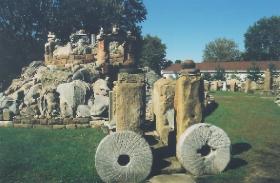
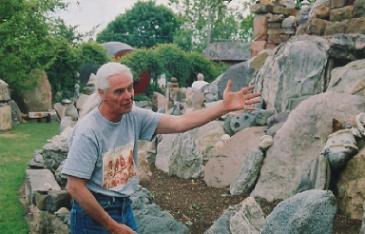
 photos by Larry Harris
photos by Larry Harris
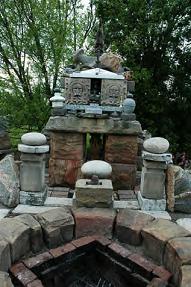
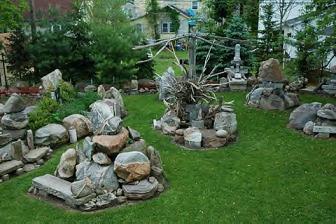
 photos by Tom LaFaver
photos by Tom LaFaver
Jim Bowsher's Temple of Tolerance, Wapakoneta, OH
Our gang was exhausted from this exciting day when we arrived at our lodgings. However some
members of the tour group zipped over to the Groundhog Sports Grill for burgers, fries, onion
rings and, of course, pitchers of cold beer. Several took over the pool table, displaying
expert skills at the game while claiming never to have picked up a cue. It brought back
memories of the mythical hustler "Fast" Eddie Felson.
We awoke to another beautiful morning and another day of Eyeopener eye candy. Harry
Andrews began construction of Chateau LaRoche in 1929. He continued building for the
next 50 years and ended up with a stone Norman-style castle overlooking the Great Miami river.
It almost seems as if a Wizard of Oz-like tornado scooped the fortress off the plains of
Salisbury and deposited it in rural Loveland, Ohio. It also serves as the home of the Knights
of the Golden Trail, a group of medieval re-enactors who meet monthly, dress in chain mail
and armor and address each other as "Sir So-In-So." The grounds are beautifully manicured by a
group of volunteers (mostly knights sans armor) and feature a rock garden with a Loch Ness
Monster swimming through the pebbles.

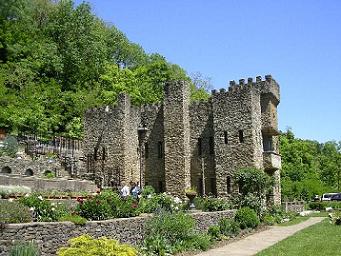
 photo by Barbara Hinton
photo by Barbara Hinton
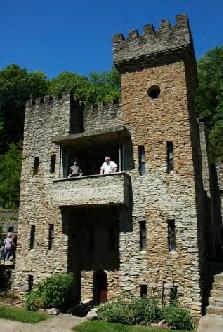
 photo by Tom LaFaver
photo by Tom LaFaver
Chateau LaRoche, Loveland, OH
Then it was off to Cincinnati for an excellent lunch served on an outdoor patio at Trio.
(By now it must seem clear that malnutrition is not an issue on an Eyeopener Tour.)
With sated appetites we headed to the historic Spring Grove Cemetery and Arboretum.
This 773-acre burying ground is the second largest cemetery in America. Our docent/guide
was Spring Grove historian Phil Nuxhall. He pointed out a number of fantastic tombstones and
mausoleums where the rich and famous of Cincinnati have lain in repose since 1845, awaiting
the Second Coming. Because of our arrival on Memorial Day Eve the cemetery was filled with
flowers. Many families have carried out this tradition for decades especially those of Irish Traveller heritage.

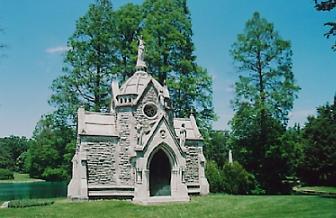
 photo by Larry Harris
photo by Larry Harris
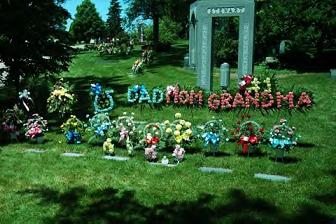
 photo by Tom LaFaver
photo by Tom LaFaver
Spring Grove Cemetery, Cincinnati, OH
Our visit to the Visionaries and Voices Gallery was one of the most rewarding of the tour.
Bill Ross and Keith Banner are social workers. In their travels they began discovering hidden artists, many of
whom were physically and/or mentally challenged. Bill and Keith opened this art space in 2003
so these individuals would have a place to express their artistic talents. We were fortunate
that many of these artists were painting and sculpting when we arrived. Antonio Adams was
constructing a totem. Joe Kessler talked about what he calls his "paperlings," collages made
of layers of paper cuttings. Kevin White was sketching surreal patterns on a roll of paper
towels. It was a moving experience to meet these wonderful people, watch them work and invest
a few dollars in a piece of their art. As a small token of our appreciation for all the hard
work Larry did in preparing this out of this world tour, the group chipped in and bought
him a Raymond Thunder-Sky drawing. This Cincinnati icon walked the city's streets wearing a
clown collar and hard hat sketching buildings that were being demolished.

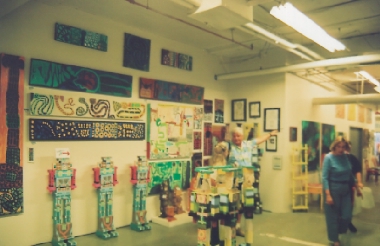
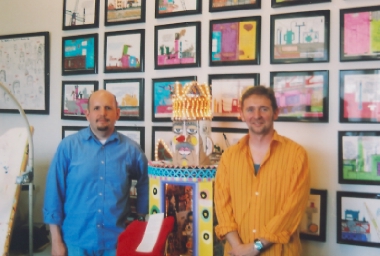
 photos by Larry Harris
photos by Larry Harris
Bill Ross and Keith Banner, founders of
Visionaries and Voices Gallery, Cincinnati, OH
We checked into the Art Deco Netherland Plaza Hotel where we had a guided tour scheduled the
next morning. Then to stave off starvation we headed to the Montgomery Inn Boathouse
Restaurant to pig out on half, full and double slabs of barbequed pork ribs, after all it
had been six hours since our last meal.

Memorial Day morning we awoke to a frog-strangling rain storm but it did nothing to dampen the
spirits of our hardy band of travelers. We were met in the lobby by the executive manager of
the Netherland Plaza Hotel who took us for an extensive tour of this architectural jewel.
Words fail to give justice to this outrageously decorated Art Deco masterpiece. Murals cover
the ceiling of the Grand Staircase leading to the Main Lobby whose walls are covered with rare
Brazilian rosewood. The two-story Palm Court is surrounded by Louis XV-style paintings,
contains a Rookwood Pottery ram's head fountain and gigantic seahorses and a ceiling mural
depicting Apollo and Diana. The Continental Room, once the hotel's main dining room contained
a skating rink when the hotel opened in 1931. The Hall of Mirrors serves as the grand ballroom.
The walls are lined with mirrors backed by 24-carat gold flakes to create a mellow golden
glow throughout the room.

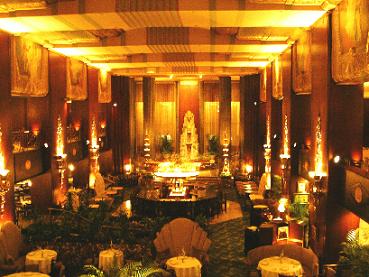
 photo by Barbara Hinton
photo by Barbara Hinton
Netherland Plaza Hotel, Cincinnati, OH
For many years Zaha Hadid was the Anna Kournikova of architecture; lots of show but no wins.
Throughout the 80's and 90's Hadid was winning competitions and commissions,
although none of her designs were getting constructed. Finally in 2004 her largest built work, the Contemporary Arts Center
of Cincinnati, opened to rave reviews and international acclaim. It is a striking building indeed
with its gravity defying appearance. As you enter the building the ground floor slowly rises
to become the back wall. The suspended mezzanine floor runs the full length of the lobby. The
staircase zigzags through a narrow slit in the rear of the structure like a 3-D jigsaw puzzle.
Various sized galleries are located on floors two to six. Since the museum has no permanent
collection shows are constantly being mounted.

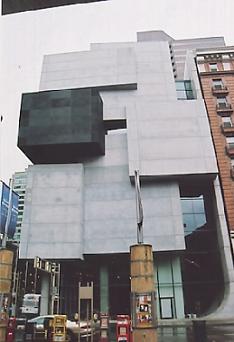
 photo by Larry Harris
photo by Larry Harris
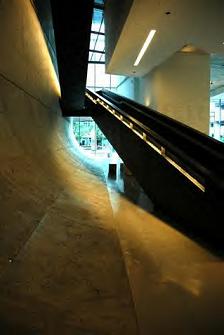
 photo by Tom LaFaver
photo by Tom LaFaver
Contemporary Arts Center, Cincinnati, OH
Cincinnati Union Terminal was the next to last of the grand railroad stations built in America
(Los Angeles terminal was finished in 1939). The building sits on an elevated plaza.
Its semicircular façade is 200 feet in diameter. The Art Deco interior is delightful with
its mosaic murals, carved linoleum panels, etched glass and prolific use of aluminum
(the metal of the future in the early years of the last century.) The colorful half dome is
the largest in the world. Booths in the ice cream parlor are made of Rookwood tiles featuring
dragonflies, flowers and butterflies. Fortunately the executive suite was saved and
renovated. It features modernistic furniture, inlaid wooden walls and empire state
building-shaped andirons. Our docent did an excellent job especially explaining how the décor
was intended to show Cincinnati in the 21st century. Murals contain images of blimps,
thought to be the way air travel would be then. (Did you know that because a blimp does not
have a rigid substructure like a dirigible when not filled with gas it is limp? The first
design was the "A limp" which did not work. However, the "B limp" was a success thus the name
blimp. No kidding. I'm not making this stuff up.)

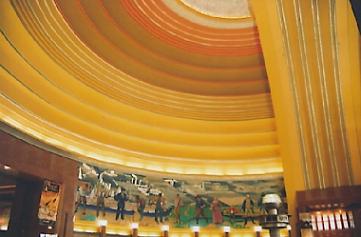
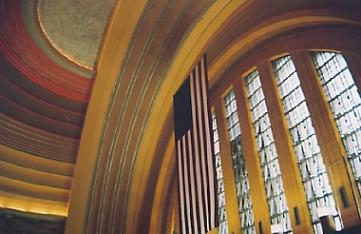
 photos by Larry Harris
photos by Larry Harris
Union Terminal, Cincinnati, OH
Our final stop on this phantasmagorical tour was the recently opened American Sign Museum.
Tod Swormstedt, editor of the trade magazine Signs of the Times, felt much of the history of
the sign business was being lost. So he began going around America buying up old signs.
His collection is now assembled in a huge warehouse. It is a fascinating history of the
development of signs. Visitors see goldleaf glass signs, painted/non-illuminated signs,
pre-neon electric signs, neon signs, plastic signs and signshop signs. It is truly a visual
overload of bright, flashing lights.

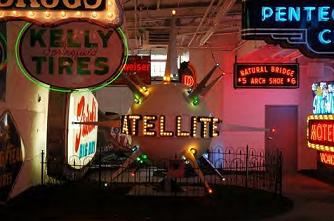
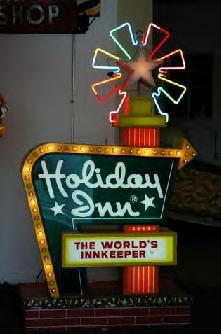
 photos by Tom LaFaver
photos by Tom LaFaver
American Sign Museum, Cincinnati, OH
Well, to quote Bugs Bunny, "That's all folks." Thanks again to Larry for his hard work
putting this annual pilgrimage together. And we would like to thank all the wonderful people
who so graciously gave of themselves and their time to make this trip another memorable
Eyeopener Tour.
back to more roadtrips
back to the home of NarrowLarry




![]()










![]()









![]()














![]()






